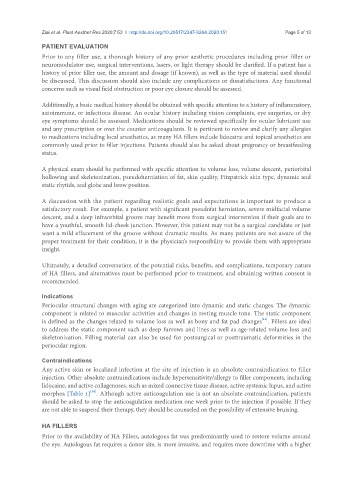Page 613 - Read Online
P. 613
Ziai et al. Plast Aesthet Res 2020;7:53 I http://dx.doi.org/10.20517/2347-9264.2020.151 Page 5 of 13
PATIENT EVALUATION
Prior to any filler use, a thorough history of any prior aesthetic procedures including prior filler or
neuromodulator use, surgical interventions, lasers, or light therapy should be clarified. If a patient has a
history of prior filler use, the amount and dosage (if known), as well as the type of material used should
be discussed. This discussion should also include any complications or dissatisfactions. Any functional
concerns such as visual field obstruction or poor eye closure should be assessed.
Additionally, a basic medical history should be obtained with specific attention to a history of inflammatory,
autoimmune, or infectious disease. An ocular history including vision complaints, eye surgeries, or dry
eye symptoms should be assessed. Medications should be reviewed specifically for ocular lubricant use
and any prescription or over the counter anticoagulants. It is pertinent to review and clarify any allergies
to medications including local anesthetics, as many HA fillers include lidocaine and topical anesthetics are
commonly used prior to filler injections. Patients should also be asked about pregnancy or breastfeeding
status.
A physical exam should be performed with specific attention to volume loss, volume descent, periorbital
hollowing and skeletonization, pseudoherniation of fat, skin quality, Fitzpatrick skin type, dynamic and
static rhytids, and globe and brow position.
A discussion with the patient regarding realistic goals and expectations is important to produce a
satisfactory result. For example, a patient with significant pseudofat herniation, severe midfacial volume
descent, and a deep infraorbital groove may benefit more from surgical intervention if their goals are to
have a youthful, smooth lid-cheek junction. However, this patient may not be a surgical candidate or just
want a mild effacement of the groove without dramatic results. As many patients are not aware of the
proper treatment for their condition, it is the physician’s responsibility to provide them with appropriate
insight.
Ultimately, a detailed conversation of the potential risks, benefits, and complications, temporary nature
of HA fillers, and alternatives must be performed prior to treatment, and obtaining written consent is
recommended.
Indications
Periocular structural changes with aging are categorized into dynamic and static changes. The dynamic
component is related to muscular activities and changes in resting muscle tone. The static component
[14]
is defined as the changes related to volume loss as well as bony and fat pad changes . Fillers are ideal
to address the static component such as deep furrows and lines as well as age-related volume loss and
skeletonization. Filling material can also be used for postsurgical or posttraumatic deformities in the
periocular region.
Contraindications
Any active skin or localized infection at the site of injection is an absolute contraindication to filler
injection. Other absolute contraindications include hypersensitivity/allergy to filler components, including
lidocaine, and active collagenoses, such as mixed connective tissue disease, active systemic lupus, and active
[18]
morphea [Table 1] . Although active anticoagulation use is not an absolute contraindication, patients
should be asked to stop the anticoagulation medication one week prior to the injection if possible. If they
are not able to suspend their therapy, they should be counseled on the possibility of extensive bruising.
HA FILLERS
Prior to the availability of HA Fillers, autologous fat was predominantly used to restore volume around
the eye. Autologous fat requires a donor site, is more invasive, and requires more downtime with a higher

